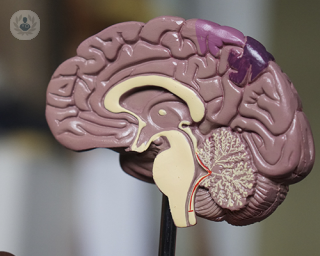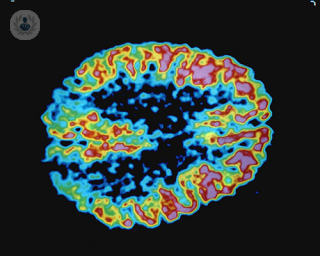What is epilepsy surgery?
Epilepsy surgery is a surgical procedure that is performed when patients who have epilepsy do not respond adequately to medication. This is relevant to approximately 20 per cent of cases, and in these cases, the patient’s quality of life is severely affected by this ailment.
The surgical technique used depends on each patient and consists of removing the area of the brain that produces epileptic seizures as long as this does not damage brain areas necessary for normal functioning.

Why is epilepsy surgery done?
In some cases, medications are unable to control seizures, which is known medically as drug-resistant epilepsy. The goal of epilepsy surgery is to eradicate seizures or limit their severity, without the need for medication.
What are the risks of an epileptic seizure?
If epilepsy is poorly-controlled, it may result in any of the following:
- physical injuries
- drowning if a seizure occurs (when you are in water)
- depression and anxiety
- decline in memory
- developmental delays in children
- sudden death (which is very rare)
What are the risks of epilepsy surgery?
The risks of surgery depend on which part of the brain would need treatment and the type of surgical procedure.
Risks may include:
- memory and language problems
- visual impairment
- mood changes
The surgeon will discuss the potential risks of surgery with you to ensure that you fully understand.
What are the types of epilepsy brain surgery?
There are different types of epilepsy surgery, including procedures where only part of the brain is taken away (resection surgery).
The different types of resection surgery are:
- Temporal lobectomy: Brain tissue from the temporal lobes that cause seizures is cut away.
- Extratemporal resection: Brain tissue in other parts of the brain is cut away
- Lesionectomy: Tumours or abscesses that have been causing seizures are cut away.
If resection surgery is not possible, there are other types of surgeries where one part of the brain is disconnected from another part. These include:
- Hemispherectomy: Where the outer layer of one half of the brain is removed.
- Corpus callosotomy: Where the connections between the two sides of the brain are cut.
- Multiple subpial transections: Where the nerve fibres in the outer layers of the brain are cut.
What happens during epilepsy surgery?
This depends on the type of surgery. A general anaesthetic will put you to sleep and the surgeon will make a small opening in your skull to get to your brain.
In some cases, the surgeon will wake you up during the operation to help locate the part of your brain that controls language and movement. After surgery, the bone is replaced and fixed to the skull to heal.
Will my seizures stop after epilepsy surgery?
The results of surgery will depend on the individual case and the type of epilepsy surgery. Your doctor will discuss with you what your expected success rate of surgery will be.
11-13-2012 08-25-2023Epilepsy surgery
Mr Jonathan Hyam - Neurosurgery
Created on: 11-13-2012
Updated on: 08-25-2023
Edited by: Carlota Pano
What is epilepsy surgery?
Epilepsy surgery is a surgical procedure that is performed when patients who have epilepsy do not respond adequately to medication. This is relevant to approximately 20 per cent of cases, and in these cases, the patient’s quality of life is severely affected by this ailment.
The surgical technique used depends on each patient and consists of removing the area of the brain that produces epileptic seizures as long as this does not damage brain areas necessary for normal functioning.

Why is epilepsy surgery done?
In some cases, medications are unable to control seizures, which is known medically as drug-resistant epilepsy. The goal of epilepsy surgery is to eradicate seizures or limit their severity, without the need for medication.
What are the risks of an epileptic seizure?
If epilepsy is poorly-controlled, it may result in any of the following:
- physical injuries
- drowning if a seizure occurs (when you are in water)
- depression and anxiety
- decline in memory
- developmental delays in children
- sudden death (which is very rare)
What are the risks of epilepsy surgery?
The risks of surgery depend on which part of the brain would need treatment and the type of surgical procedure.
Risks may include:
- memory and language problems
- visual impairment
- mood changes
The surgeon will discuss the potential risks of surgery with you to ensure that you fully understand.
What are the types of epilepsy brain surgery?
There are different types of epilepsy surgery, including procedures where only part of the brain is taken away (resection surgery).
The different types of resection surgery are:
- Temporal lobectomy: Brain tissue from the temporal lobes that cause seizures is cut away.
- Extratemporal resection: Brain tissue in other parts of the brain is cut away
- Lesionectomy: Tumours or abscesses that have been causing seizures are cut away.
If resection surgery is not possible, there are other types of surgeries where one part of the brain is disconnected from another part. These include:
- Hemispherectomy: Where the outer layer of one half of the brain is removed.
- Corpus callosotomy: Where the connections between the two sides of the brain are cut.
- Multiple subpial transections: Where the nerve fibres in the outer layers of the brain are cut.
What happens during epilepsy surgery?
This depends on the type of surgery. A general anaesthetic will put you to sleep and the surgeon will make a small opening in your skull to get to your brain.
In some cases, the surgeon will wake you up during the operation to help locate the part of your brain that controls language and movement. After surgery, the bone is replaced and fixed to the skull to heal.
Will my seizures stop after epilepsy surgery?
The results of surgery will depend on the individual case and the type of epilepsy surgery. Your doctor will discuss with you what your expected success rate of surgery will be.


Drug-resistant epilepsy (DRE): What are my next treatment options?
By Professor Matthew Walker
2025-01-16
Epilepsy treatment, while overall very successful, can function differently in some patients. Some people with epilepsy are resistant to epilepsy medication and rely on other treatment methods to control their seizures. Professor Matthew Walker, a top neurological clinician, expert in the field of epilepsy and a winner of the Top Doctor 2018 awards, explains why epilepsy medication doesn’t work on everyone with the condition and describes the next available treatment options. See more


Epilepsy – the 6 types of seizures
By Mr Richard Selway
2025-01-13
Epilepsy is a neurological disorder affecting 1 in 100 people in the UK, and it is characterised by seizures. Typically, seizures may involve uncontrolled, jerky movements, but in fact, did you know that there are 6 different types of seizure? Mr Richard Selway of the London Neurosurgery Partnership describes the characteristics of each type of seizure. See more


How can epilepsy be treated?
By Professor Matthew Walker
2024-12-16
Epilepsy is a neurological condition that affects how the nerve cells in the brain send signals, resulting in seizures. Professor Matthew Walker discusses the various treatment options for epilepsy, including antiepileptic medications, nerve stimulation therapy, surgery and even the ketogenic diet. See more
Experts in Epilepsy surgery
-
Mr Christopher Chandler
NeurosurgeryExpert in:
- Paediatric neurosurgery
- Hydrocephalus
- Brain tumour
- Brain metastasis
- Neuro-oncology
- Epilepsy surgery
-
Mr Richard Selway
NeurosurgeryExpert in:
- Epilepsy
- Epilepsy surgery
- Spinal surgery
- Trigeminal neuralgia
- Brain tumour
- Parkinson's disease
-
Professor Matthias Koepp
NeurologyExpert in:
- Epilepsy
- Epilepsy surgery
- Seizures
- Amnesia
- Learning disabilities
- Cognitive impairment
-
Dr Sofia Eriksson
NeurologyExpert in:
- Epilepsy
- Sleep disorders
- Seizures
- Neuropsychology
- Insomnia
- Epilepsy surgery
-
Dr Alex Everitt
NeurologyExpert in:
- Epilepsy
- Epilepsy surgery
- Chronic headache
- Cluster headaches
- Chronic fatigue
- Headache
- See all

Cleveland Clinic London Hospital
Cleveland Clinic London Hospital
33 Grosvenor Place, SW1X 7HY
No existe teléfono en el centro.
By using the telephone number provided by TOP DOCTORS, you automatically agree to let us use your phone number for statistical and commercial purposes. For further information, read our Privacy Policy
Top Doctors

The Harley Street Clinic - part of HCA Healthcare
The Harley Street Clinic - part of HCA Healthcare
35 Weymouth Street, London. W1G 8BJ
No existe teléfono en el centro.
By using the telephone number provided by TOP DOCTORS, you automatically agree to let us use your phone number for statistical and commercial purposes. For further information, read our Privacy Policy
Top Doctors

London Neurosurgery Partnership (HCA)
London Neurosurgery Partnership (HCA)
78 Harley St, London W1G 7HJ
No existe teléfono en el centro.
By using the telephone number provided by TOP DOCTORS, you automatically agree to let us use your phone number for statistical and commercial purposes. For further information, read our Privacy Policy
Top Doctors
-
Cleveland Clinic London Hospital
33 Grosvenor Place, SW1X 7HY, Central LondonExpert in:
- Cardiology
- Colorectal surgery
- Minimal access surgery (keyhole surgery)
- Gallbladder surgery
- Diagnostic Imaging
- Ultrasound
-
The Harley Street Clinic - part of HCA Healthcare
35 Weymouth Street, London. W1G 8BJ, Central LondonExpert in:
- Cancer
- Head and neck cancer
- Cardiology
- Intensive care
- Diagnostic Imaging
- Women’s health
-
London Neurosurgery Partnership (HCA)
78 Harley St, London W1G 7HJ, W1G Marylebone LondonExpert in:
- Minimal access surgery (keyhole surgery)
- Neurological spinal surgery
- Back pain
- Neurosurgery
- Brain and spinal tumours
- See all
- Most viewed diseases, medical tests, and treatments
- Trigeminal neuralgia
- Narcolepsy
- Alzheimer's disease
- Cluster headaches
- Tension headache
- Chronic headache
- Peripheral nerve block
- Peripheral neuropathy
- Neuro-ophthalmology
- Migraine








